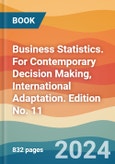Business Statistics uses current real-world data to equip students with the business analytics techniques and quantitative decision-making skills required to make more thoughtful, information-based decisions in today's workplace. Helping the student understand business analytics and the role that business statistics plays in it, the book has infused the language of business analytics along with its definitions, approaches, and explanations throughout the text.
Continuing the tradition of presenting and explaining business statistics using clear, complete, and student-friendly pedagogy, this international edition includes new chapter cases reinforcing the vibrancy and relevance of statistics. In addition, topical changes have been made in select chapters and problems have been revised in all the chapters.
Table of Contents
ABOUT THE AUTHOR vii
PREFACE ix
1 Introduction to Statistics and Business Analytics 1
2 Visualizing Data with Charts and Graphs 23
3 Descriptive Statistics 57
4 Probability 91
5 Discrete Random Variables and Their Probability Distributions 129
6 Continuous Random Variables and Normal Distributions 169
7 Sampling and Sampling Distributions 205
8 Statistical Inference: Estimation for Single Populations 235
9 Statistical Inference: Hypothesis Testing for Single Populations 269
10 Statistical Inferences About Two Populations 317
11 Analysis of Variance and Design of Experiments 369
12 Simple Regression Analysis and Correlation 425
13 Multiple Regression Analysis 473
14 Building Multiple Regression Models 501
15 Time-Series Forecasting and Index Numbers 549
16 Analysis of Categorical Data 603
17 Nonparametric Statistics 623
18 Statistical Quality Control 669
19 Decision Analysis 711
APPENDIX A Tables 747
APPENDIX B Answers to Selected Problems 789
GLOSSARY 795
INDEX 803








